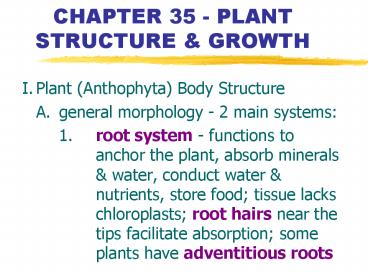CHAPTER 35 PLANT STRUCTURE - PowerPoint PPT Presentation
1 / 13
Title:
CHAPTER 35 PLANT STRUCTURE
Description:
1. root system - functions to anchor the plant, absorb minerals & water, ... classes in Anthophyta; examples: roses, peas, buttercups,sunflowers, oaks, & maples ... – PowerPoint PPT presentation
Number of Views:162
Avg rating:3.0/5.0
Title: CHAPTER 35 PLANT STRUCTURE
1
CHAPTER 35 - PLANT STRUCTURE GROWTH
- I. Plant (Anthophyta) Body Structure
- A. general morphology - 2 main systems
- 1. root system - functions to anchor the
plant, absorb minerals water, conduct water
nutrients, store food tissue lacks
chloroplasts root hairs near the tips
facilitate absorption some plants have
adventitious roots
2
2 plant systems (cont.)
- 2. shoot system - consists of 3 organs
- a. stems - function to support position
the leaves many plants have modified stems
(stolons, rhizomes, tubers, bulbs) with
modified functions - b. leaves - main photosynthetic organ many
plants with modified leaves (tendrils, spines,
etc.) - c. flowers - discussed in Ch. 38
3
B. anatomy
- 1. 7 specialized plant cells
- a. parenchyma cells - the typical plant
cell relatively unspecialized carry out much
of the plants metabolism - b. collenchyma cells - have thicker primary
walls help support young part of the plant
without restraining growth
4
7 plant cells (cont.)
- c. sclerenchyma cells - thick secondary walls
usually strengthened by lignin supports the
plant dead at maturity two forms fibers
sclereids - d. tracheids - have secondary walls hardened
with lignin dead at maturity long thin with
tapered ends conduct water provide support
5
7 plant cells (cont.)
- e. vessel elements - like tracheids but wider,
shorter, thinner-walled, less tapered end
walls are perforated - f. sieve-tube members - alive at maturity but
lack major organelles porous end walls called
sieve plates transport food - g. companion cells - support the sieve- tube
members may help load sugar
6
2. 3 tissue types
- a. dermal tissue (epidermis) - single layer of
tightly packed cells that protects the plant
gives rise to root hairs secretes the cuticle
on the shoot - b. vascular tissue (xylem phloem) -
transports water nutrients and provides
support - c. ground tissue - everything else made up
primarily of parenchyma
7
II. Plant Growth
- A. primary growth - elongation
- 1. root
- a. zone of cell division - apical meristem
( derivitives) region of mitosis protected
by root cap - b. zone of elongation - elongation of cells
which pushes the root tip forward - c. zone of maturation - cells begin to
specialize
8
2. stem primary growth
- a. apical meristem - at the tip of the terminal
bud is the main region of mitosis elongation
occurs by growth (both cell division and
elongation) of slightly older internodes below
the tip - b. axillary buds - formed by left over
islands of apical meristem can form a side
branch, but usually inhibited by the terminal
bud apical dominance
9
B. secondary growth - increasing girth
- 1. roots - 2 lateral meristems
- a. vascular cambium - forms within the stele
and produces secondary xylem to its inside and
secondary phloem to its outside cortex
epidermis are split and shed - b. cork cambium - forms from the pericycle and
produces periderm which replaces epidermis
10
2. stem secondary growth
- a. vascular cambium - a meristematic layer that
develops between primary xylem phloem and
which produces secondary xylem (wood) to its
interior and secondary phloem to its exterior - b. cork cambium - a meristematic layer that
forms in the outer cortex and which produces
cork to replace the sloughed epidermis ?
periderm
11
III. Monocots vs. Dicots
- A. monocots - one of two classes in
Anthophyta examples lilies, orchids, yuccas,
palms, grasses (including lawn grasses, sugar
cane, grains) - B. dicots - one of two classes in Anthophyta
examples roses, peas, buttercups,sunflowers,
oaks, maples
12
Monocots vs. Dicots (cont.)
- arrangement of vascular bundles in the root
monocot in a ring vs. dicot in an X - shape of guard cells monocot - dumbbell vs.
dicot - kidney
13
Monocots vs. Dicots (cont.)
- In monocots endosperm provides nutrition to
germinated seedling. In dicots the nutritive
function is transferred to the cotyledons. - During germination the monocot shoot pushes
straight up, while the dicot shoot tip is pulled
up by a hook in the embryonic axis.































